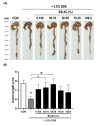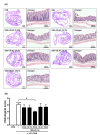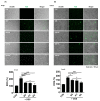Bamboo Shoot and Artemisia capillaris Extract Mixture Ameliorates Dextran Sodium Sulfate-Induced Colitis
- PMID: 36286060
- PMCID: PMC9600592
- DOI: 10.3390/cimb44100345
Bamboo Shoot and Artemisia capillaris Extract Mixture Ameliorates Dextran Sodium Sulfate-Induced Colitis
Abstract
Inflammatory bowel disease (IBD) is a chronic inflammatory disease of the gastrointestinal tract and is characterized by recurrent chronic inflammation and mucosal damage of the gastrointestinal tract. Recent studies have demonstrated that bamboo shoot (BS) and Artemisia capillaris (AC) extracts enhance anti-inflammatory effects in various disease models. However, it is uncertain whether there is a synergistic protective effect of BS and AC in dextran sodium sulfate (DSS)-induced colitis. In the current study, we tested the combined effects of BS and AC extracts (BA) on colitis using in vivo and in vitro models. Compared with control mice, oral administration of DSS exacerbated colon length and increased the disease activity index (DAI) and histological damage. In DSS-induced colitis, treatment with BA significantly alleviated DSS-induced symptoms such as colon shortening, DAI, histological damage, and colonic pro-inflammatory marker expression compared to single extracts (BS or AC) treatment. Furthermore, we found BA treatment attenuated the ROS generation, F-actin formation, and RhoA activity compared with the single extract (BS or AC) treatment in DSS-treated cell lines. Collectively, these findings suggest that BA treatment has a positive synergistic protective effect on colonic inflammation compared with single extracts, it may be a highly effective complementary natural extract mixture for the prevention or treatment of IBD.
Keywords: Artemisia capillaris; bamboo shoot; colitis; dextran sodium sulfate; inflammatory bowel disease.
Conflict of interest statement
The authors declare no conflict of interest.
Figures






References
-
- Centers for Disease Control and Prevention Inflammatory Bowel Disease (IBD) [(accessed on 6 August 2012)]; Available online: http://www.cdc.gov/ibd/#epidIBD.
Grants and funding
LinkOut - more resources
Full Text Sources

